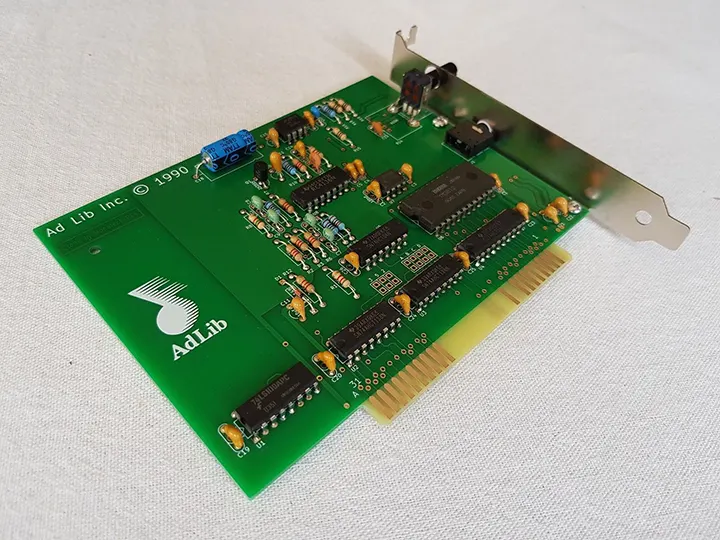The OPL2/Adlib Soundcard: A Deep Dive into 90s PC Gaming Audio
The OPL2 (also known as the Yamaha YM2151) and the Adlib soundcard (which used the OPL2 chip) are iconic pieces of PC gaming history. They were the sound cards for a generation, bringing a level of audio immersion to games that was previously unheard of on IBM PCs. Here’s a comprehensive look at their history, technology, impact, and legacy:
1. The Pre-Soundcard Era & The Need for Better Audio
Before the late 80s, PC audio was… rudimentary. The IBM PC’s built-in speaker (often called the “PC speaker”) could only produce simple beeps and tones. Games relied on these limited sounds for basic effects. This was fine for early games, but as games became more complex, developers craved richer, more expressive audio.
2. The Yamaha YM2151 (OPL2) Chip: The Heart of the Sound
- FM Synthesis: The YM2151 is a Frequency Modulation (FM) synthesis chip. Instead of storing pre-recorded samples (like later sound cards would do), it generates sounds by manipulating sine waves. This is done by modulating the frequency of one sine wave with another. It’s a complex process, but it allows for a surprisingly wide range of sounds.
- 9 Channels: The OPL2 has 9 channels of sound. These channels are often grouped into:
- 6 Melody Channels: Used for musical instruments and melodies.
- 3 Percussion Channels: Used for drum sounds and other percussive effects.
- Digital Signal Processing (DSP): The chip includes some basic DSP capabilities, allowing for effects like vibrato, tremolo, and envelope control.
- Relatively Inexpensive: Crucially, the YM2151 was relatively inexpensive to manufacture, making it a viable option for inclusion in sound cards.
3. Adlib: Bringing the OPL2 to the Masses
- Adlib, Inc.: Adlib, Inc. was a Canadian company that didn’t make the OPL2 chip. They licensed the chip from Yamaha and created a sound card around it.
- The Adlib Gold: The original Adlib card, released in 1987, was a huge success. It was one of the first affordable sound cards that offered a significant improvement over the PC speaker. It featured the YM2151 chip, 64KB of RAM (for storing instrument definitions), and a simple interface.
- Why Adlib Became Synonymous with OPL2: Adlib was the first to market with a widely available OPL2-based sound card. Because of this, the terms “Adlib” and “OPL2” became almost interchangeable, even though other companies also made OPL2 cards.
- Game Support: Game developers quickly embraced the Adlib. Games were often programmed to specifically support the Adlib, providing a much richer audio experience than was possible with the PC speaker. Many games would even require an Adlib card to run properly.
4. The Rise of Sound Blaster & The Decline of Adlib
- Creative Labs Sound Blaster: In 1989, Creative Labs released the Sound Blaster, which initially also used the YM2151 chip. However, the Sound Blaster quickly added a digital signal processor (DSP) chip for improved audio quality and, crucially, sample-based sound. This meant it could play back pre-recorded sounds, offering a much more realistic and versatile soundscape.
- Sound Blaster’s Advantages: The Sound Blaster’s ability to play samples, combined with its lower price and aggressive marketing, quickly made it the dominant sound card.
- Adlib’s Response: Adlib attempted to compete with the Sound Blaster, releasing the Adlib Platinum and Adlib Jukebox, but they couldn’t match the Sound Blaster’s features and market share.
- Adlib’s Demise: Adlib, Inc. went bankrupt in 1992. However, the legacy of the Adlib soundcard lived on through the games that were designed for it.
5. Games Famous for Their Adlib/OPL2 Soundtracks
This is where the OPL2 truly shines. Many classic games are defined by their Adlib soundtracks. Here are just a few examples:
- Commander Keen Series: Iconic and energetic tunes.
- Duke Nukem II: Fast-paced and memorable.
- Epic Pinball: Fantastic renditions of popular songs.
- Jill of the Jungle: Catchy and adventurous.
- One Must Fall: 2097: Excellent robotic and futuristic sounds.
- Secret Weapons of the Luftwaffe: Intense and atmospheric.
- X-Wing: The Adlib version had a unique and beloved soundscape.
- Wing Commander: Early Wing Commander games had excellent Adlib support.
- The Secret of Monkey Island: While the Sound Blaster version is more common, the Adlib version has a distinct charm.
6. The OPL2’s Legacy & Modern Revival
- Nostalgia: For many gamers who grew up in the 90s, the sound of the Adlib/OPL2 is deeply nostalgic. It evokes a specific era of PC gaming.
- MIDI Music: The OPL2 was often used to play MIDI (Musical Instrument Digital Interface) files. This meant that games could have complex and dynamic soundtracks.
- Emulation: Modern PC emulators (like DOSBox) can accurately emulate the OPL2 chip, allowing you to experience classic games with their original soundtracks.
- Modern OPL2 Projects: There’s a surprising amount of interest in the OPL2 today.
- OPL2 MIDI Players: Software players that can render MIDI files using the OPL2 chip.
- Hardware Recreations: Projects to recreate the OPL2 chip in modern hardware.
- OPL3 (and beyond): Yamaha continued to develop FM synthesis chips, with the OPL3 being a popular successor.
- Retro Gaming Communities: Active communities dedicated to preserving and enjoying classic games and their soundtracks.
Resources for Further Exploration
- Wikipedia – Yamaha YM2151: https://en.wikipedia.org/wiki/Yamaha_YM2151
- Wikipedia – AdLib: https://en.wikipedia.org/wiki/Ad_Lib,_Inc.
- VGMdb (Video Game Music Database): https://vgmdb.net/ – A great resource for finding game soundtracks, including those for the Adlib.
- DOSBox Wiki: https://www.dosbox.com/wiki/ – Information on configuring DOSBox to emulate the OPL2.
In conclusion, the OPL2/Adlib soundcard was a pivotal moment in PC gaming history. It brought a new level of audio immersion to games, and its unique sound continues to be cherished by gamers today. It’s a testament to the power of clever engineering and the enduring appeal of retro gaming.
